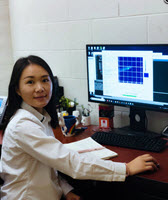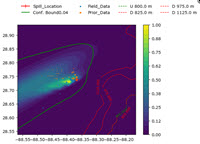
When a marine oil spill occurs, it is vital to quickly determine where and when to dispatch response operations. Visualization and remote sensing techniques help locate oil on surface waters but have limitations in locating subsurface oil, such as oil that lingers in the water column or settles to the bottom. During Deepwater Horizon, researchers developed for the NOAA Response and Restoration’s Emergency Response Division an open-source predictive model that infers where submerged oil is and predicts where it will go using near real-time field sampling data. This model, called the inferential Subsurface Oil Simulator (SOSim) model, could assess sunken oil on relatively flat bay bottoms and continental shelves but only for a single complete discharge of oil.
Chao Ji is helping to develop a next-generation SOSim model that integrates reconnaissance, flow field, and bathymetric data to address a continuous spill situation and various seafloor topography. “The model’s output is a 3D map showing the probability of finding submerged oil in different locations,” she explained. “The updated SOSim model can provide a sampling plan that tells emergency responders where they can get a submerged oil sample in the event of a future spill.”
Chao is a Ph.D. student with the University of Miami’s Department of Civil, Architecture, and Environmental Engineering and a GoMRI Scholar with the project Inferential/Parametric Forecasting of Subsurface Oil Trajectory Integrating Limited Reconnaissance Data with Flow Field Information for Emergency Response.
Her Path

Growing up, Chao found great joy in discovering answers to her questions about the world, which sparked her initial interest in science. The pollution of a clean river in her hometown motivated her to conduct research that could help make the world greener. One of Chao’s first efforts toward this goal was designing a zero-energy-consuming toilet that won second prize in the Bill and Melinda Gates Foundation’s Reinvent the Toilet Challenge & Expo in China. “This experience gave me a sense of achievement and encouraged me to believe that I am the ‘right person’ for science and engineering,” said Chao. “When I heard about the tragedy caused by the Bohai Bay oil spill in China and the Deepwater Horizon spill in Gulf of Mexico, I felt a sense of responsibility as an environmental engineer to help clean up the mess.”
Chao completed a water and wastewater science and engineering undergraduate degree at Chongqing University and an environmental engineering master’s degree from the Chinese Academy of Agricultural Sciences. As a master’s student, she gained additional experience operating microscopy equipment through the Visiting Student Research Internship Program at King Abdullah University of Science and Technology in Saudi Arabia. While researching doctoral programs, Chao was fascinated by Dr. James Englehardt’s water quality engineering research at the University of Miami and named him as a preferred advisor on her application. Dr. Englehardt sent her information about his GoMRI-funded project on developing a model to track submerged oil and invited her to join his lab as a graduate researcher.
Her Work

Oil that is chemically dispersed in the deep ocean forms small droplets that can become trapped in constant density layers, where the oil’s density is the same as the surrounding water’s density. Because these layers don’t always stay at the same depth, Chao’s research began with enhancing the SOSim model’s capability to predict the location of submerged oil within these moving layers for a continuous oil spill.
Using Bayesian statistical methods, she inferred previously unknown parameters in the oil trajectory model, including average velocity, the horizontal dispersion coefficient, and the mass fraction of oil patches (smaller oil masses that have detached from the initial spilled oil mass). She then used existing Deepwater Horizon data as a case study to validate the model’s ability to predict submerged oil transport. “The model is currently using inputs about the oil’s concentration and location to infer oil patches’ individual velocity and dispersion coefficient, but these parameters will be updated over time as new information is gathered,” she explained.

Chao is currently developing a sampling plan for oil responders that will help them locate submerged oil during a spill. She is assessing four sampling plans: random sampling, even sampling, adaptive sampling, and the sampling strategy used during Deepwater Horizon response. For her experiments, the simulations from the SINTEF Oil Spill Contingency and Response (OSCAR) model serve as a ‘real’ oil spill dataset. She applies the different sampling plans to the OSCAR dataset and uses the enhanced SOSim model to infer the oil distribution resulting from each sampling approach. She then compares oil distributions from the SOSim model and the OSCAR model to determine which sampling plan approach returns the most accurate submerged oil distribution. “Although real spill observations are limited, we can use OSCAR model outputs as ‘real’ data and compare our predictions with the ‘real’ answer to determine which sampling plan is the most effective in real spill scenarios,” said Chao.
So far, Chao has completed her initial analyses for the sampling plan and will incorporate additional scenarios to determine if the plan changes for various submerged oil distributions. She hopes to further correct the SOSim model’s output and eventually enhance its capability to include oil fate.
Her Learning
Working in Dr. Englehardt’s lab, Chao experienced an atmosphere that encouraged independent and creative problem solving. “During the whole project, Dr. Englehardt asked me to think what scientific contributions will stand the test of time,” she said. “His slogan is ‘do whatever it takes,’ which inspires me to always prepare for the best.” She recalled a situation when applying Bayesian statistics where the model consistently returned strange results. Despite debugging the software dozens of times, she struggled to pinpoint the issues and worried that her project would fail. She continuously referred to her Bayesian materials and discussed various options with Dr. Englehardt until she finally discovered that a function in the model was returning a value smaller than the values the computer could represent. Relieved, she incorporated a new function to resolve the issue and started seeing results that made sense.
The GoMRI program gave Chao the opportunity to learn from and work with top international oil spill researchers, exposing her to new fields, methods, and tools. She and her colleagues presented their research at the 2019 Gulf of Mexico Oil Spill and Ecosystem Science Conference and the 2019 AMOP Technical Seminar on Environmental Contamination and Response, where they received valuable feedback and advice from fellow researchers. The team also gave two international presentations for colleagues associated with Oil Spill Response Limited, an industry-funded oil spill response cooperative. “Before my Ph.D. research, I had no idea about subsurface oil modeling,” said Chao. “So far, I have learned the current research theories and techniques and developed an open-source application written in Python. The GoMRI project helped me develop skills to create new theoretical methods and to translate the theoretical models [for real use] in software applications.”
Chao plans to apply her oil spill and data science knowledge to other pollution issues, hopefully in academia where she can inspire students the way that she was with science and engineering. “There’s a saying: I know nothing except the fact of my ignorance,” joked Chao. “I will keep updating my knowledge and skills and hopefully create something that can withstand the test of time.” She believes that curiosity is a very important part of scientific research.
Praise for Chao
Dr. Englehardt praised Chao’s team-player attitude, explaining that she works so closely with her colleagues that their individual research can be difficult to differentiate. He describes her as someone who is eager to explore new approaches, challenge conventional wisdom, and come up with innovative solutions. “[Our team] has come to know and love her ever-cheerful and unselfish nature,” he said. “We look forward to watching her career successes in the future.”
The GoMRI community embraces bright and dedicated students like Chao Ji and their important contributions. The GoMRI Scholars Program recognizes graduate students whose work focuses on GoMRI-funded projects and builds community for the next generation of ocean science professionals.
By Stephanie Ellis and Nilde Maggie Dannreuther. Contact sellis@ngi.msstate.edu for questions or comments.
************
The Gulf of Mexico Research Initiative (GoMRI) is a 10-year independent research program established to study the effect, and the potential associated impact, of hydrocarbon releases on the environment and public health, as well as to develop improved spill mitigation, oil detection, characterization and remediation technologies. An independent and academic 20-member Research Board makes the funding and research direction decisions to ensure the intellectual quality, effectiveness and academic independence of the GoMRI research. All research data, findings and publications will be made publicly available. The program was established through a $500 million financial commitment from BP. For more information, visit http://gulfresearchinitiative.org/.
© Copyright 2010-2019 Gulf of Mexico Research Initiative (GoMRI) – All Rights Reserved. Redistribution is encouraged with acknowledgement to the Gulf of Mexico Research Initiative (GoMRI). Please credit images and/or videos as done in each article. Questions? Contact web-content editor Nilde “Maggie” Dannreuther, Northern Gulf Institute, Mississippi State University (maggied@ngi.msstate.edu).
